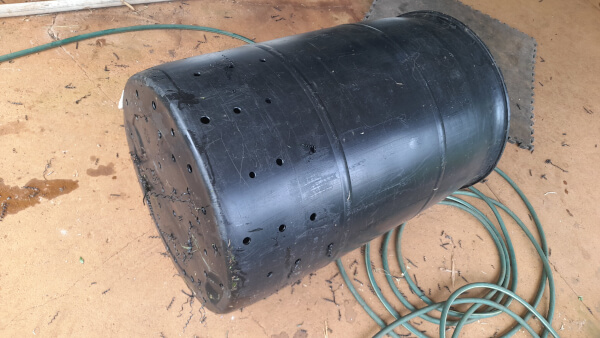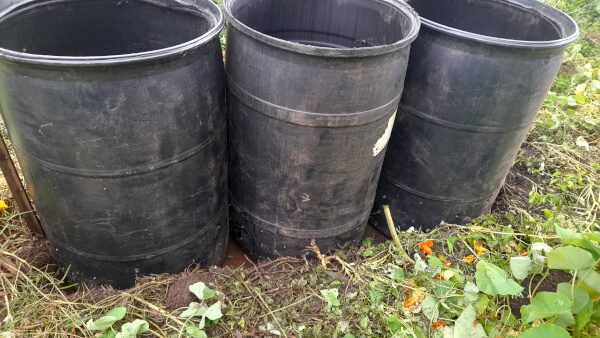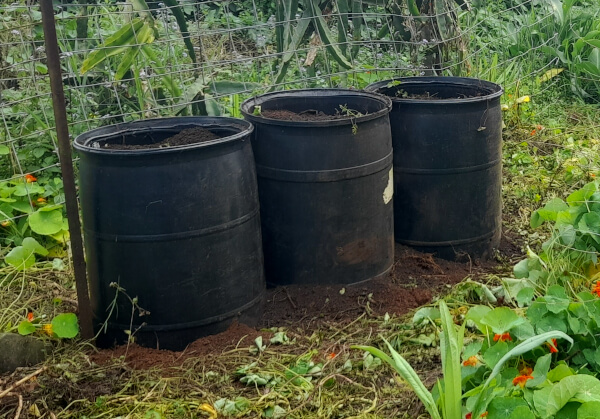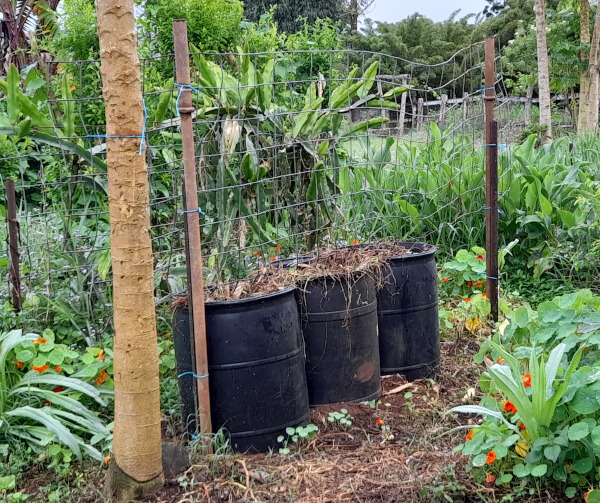This article was originally published in the November 2024 edition of What's On.
In this post I'll share why sweet potatoes are a super crop to grow at home, some ideas for protecting them from bandicoots and rats, and why it's a good idea to eat the leaves as well as the tubers.
The sweet potato plant (Ipomoea batatas) is a climbing and ground covering vine that forms swollen roots - these are the sweet potatoes themselves. You can also eat the leaves and vine tips -- more on all of this later.
Sweet potatoes can be very easy to grow, once you overcome a few challenges.
One such challenge is that the tubers can be hard to find if you allow the vines to sprawl out across the ground. Another is that rats (particularly a native rat that burrows up from underneath where we live in North Queensland, Australia), and bandicoots love sweet potatoes as much as people do.
But please don't give up! Sweet potato plants are really, really worth the effort to grow yourself and this article I'll share some tips that might help.
But first, why are sweet potato plants so worthwhile? The answer in a nutshell is "nutrition plus calories."
Sweet potatoes - nutrition AND calories
Did you know that you can eat the tips and leaves of the sweet potato vine as well as the tubers?
Sweet potato roots and greens combined give you a calorie and nutrient dense food from one growing space. Usually you get either calories or lots of nutrients, and you have to combine different plants to cover these two bases.

In the image above you can see sweet potato greens on the right (and okinawah spinach on the left).
Nutritional qualities for sweet potato tubers and greens combined
So long as you eat the leaves as well as the tubers, sweet potato plants can yield significant levels of Vitamins A, B, C, and K, as well as Thiamine, Niacin, Zinc, Folic Acid, Calcium, Riboflavin, and Iron.
Sweet potato plants are also mineral rich, providing significant magnesium, copper, manganese, phosphorus, and potassium. The tubers (especially the orange-fleshed varieties) are a good source of beta-carotene for healthy vision, and tryptophan, an essential amino acid that supports healthy sleep.
They also have a low glycemic index rating, meaning they're easy on our blood sugar balance.
The possible outcomes of regularly including sweet potato tubers and greens in your meals include improved artery and heart health, healthier eyesight, reduced inflammation, reduced risk of diabetes, cancer, and neuro-degenerative diseases, stronger bones, and healthier skin.
Cooking tips for sweet potato greens
Cook sweet potato greens any way you cook any other leafy green. Use the more tender, newer leaves, or add older leaves earlier to whatever you're cooking to give them a bit more time.
Sweet potato greens taste bitter, so add a dash of vinegar to them and serve them alongside the sweet tuber to encourage your people to eat up and get the health benefits of the bitter taste.
This post about sweet potatoes is an adapted excerpt from my book, "One Small Serve"

In One Small Serve, I show you a small and, simple home grown food approach. Learn about 7 easy, nutritious food plants that you can harvest from for years without replanting
Advantages of growing sweet potatoes in containers
Sweet potato greens and tubers can be produced in containers in a smaller space than you might think, and container growing has a few advantages for the home gardener...
Larger, impossible-to lose-tubers
Sweet potato vines grow roots where-ever the leaf nodes come in contact with the soil, and some of these roots will swell into tubers. So a sprawling, ground covering vine will produce lots of tubers, but they'll be relatively small and hard to find.
Containing them in tubs and training the vines up a trellis means less tubers, but it also means more sunlight-harvesting leaf surface (up on the trellis) per tuber. So although your tubers will be fewer, they'll impossible to loose track of and they'll also be bigger, sooner.
Rat and bandicoot proofing
By using containers with full bottoms or setting them on concrete or a hard surface, you can foil the native rats that burrow up from beneath1. You can also use containers that are too tall for a bandicoot to climb into (see pics below).
Easier to start again in case of soil-borne problems
Sweet potatoes are relatively pest and disease free but what problems they do have are often soil-borne -- so growing in containers enables you to contain the soil they grow in, and start again more easily if you need to.
In some areas, common advice is to rotate your sweet potato crop with other crops annually as pest/disease control measure - this is also easier if your sweet potatoes have been contained rather than wondering around all over the place.

We placed these sweet potato containers (above) on concrete to foil the native rats that burrow up from underneath, and on the edge of the porch where our dog lives, to foil the bandicoots. This worked as far as the rodents go, but our crop of tubers was small and disappointing.
We decided we need a trellis to keep the vines up off the ground, and bigger containers. Scroll on to see a picture story of our next iteration...
Setting up the containers and trellis

Above -- a 44 gallon drum with the top removed (keep the rim, for structural integrity) and holes drilled in the bottom and around the sides near the bottom. We were going for a balance between good drainage, which is really important for sweet potatoes, and rat proofing.
(The garden hose is not relevant; please excuse my mess...)

We placed the barrels in a trench for stability and also to try to encourage free movement of moisture, nutrients, and small soil critters between the container and the surrounding soil, while hopefully still having the tops too high for bandicoots.

We filled the barrels two thirds full with our local soil which is acidic and very free draining, both of which sweet potatoes appreciate. Then we topped them up with the heavily composted garden top soil that we had moved aside when we dug the trench.
Next will be a thin layer of composted chicken shed litter and a thick layer of mulch on top.

We started with a sturdy trellis like so (might be a bit hard to see against the background). We hope this is big/high enough -- time will tell.
Growing conditions
Sweet potatoes like well-drained, loose soil, slightly acidic. Potting mix is fine. Loose soil is important for drainage, for your tubers to be able to expand as they develop, and for easy harvesting.
For a crop of big tubers, you'll need plenty of sunlight. If open sunny spaces are limited, arrange for the vines on the trellis to reach up into the sunlight. For greens only, a shadier spot will be fine; the leaves will be bigger and softer if grown in partial shade.
Sweet potatoes need about 2 to 4 months of warm weather, reasonable sunshine, and consistent moisture to produce decent sized tubers. In tropical areas, you may be able to grow them year round.
If you're after greens only, you can use a small container. If you also want tubers, you'll need space for 5 to 10 large tubers per plant and lots of sunlight.
Starting off
Sweet potato plants can be started from "slips," which develop from sprouts on a sweet potato tuber. Or, you can take cuttings (runners) from an existing plant and use those.
Start slips throughout spring and early summer. Cover a sweet potato in soil or just leave it in a undisturbed spot well away from direct sunlight, and wait for it to sprout. (There are also tutorials available online for starting slips with chunks of sweet potato and in water, if it's of interest; that's a bit fiddly for me.)
When the sprouts are about 15 cm in length and have little roots of their own, twist or snip each one off, bringing its roots with it. Trim off the leaves on the bottom third or so and plant it carefully up to its arm pits in soil.
If you're taking cuttings from an existing plant, choose runners that are robust and growing strongly (avoid older woody ones or thin new flimsy ones). Cut them into pencil-length cuttings, remove all the leaves, and plant them upright. Submerge the bottom one third to one half of the cutting in the soil. Or you can use longer cuttings, leave a leaf or two on them, and lay them down with only their leaves exposed. They will root at each leaf node.

The pic above shows a trimmed sweet potato runner ready to plant. Zoom in to see the roots already starting at one of the leaf nodes.
Keep your baby sweet potato plants consistently moist and safe from scorching in direct sunlight until they're big and strong. Depending on how easy it will be to do this, you might want to get them big and strong before putting them out in their final postilions, or plant them direct where they are to grow.
Harvest
Harvest leaves and tips once the stems are at least 30 cm or so long, a month or two after planting. If you’re using leaves from a crop intended for root harvest, limit harvesting to a couple of times a month. If you only want greens you can harvest more often.
Harvesting tubers: Search for hard mounds indicating swollen roots just under the soil surface. Either tip the container out or burrow into it with your hands and pull out your treasures. After harvesting, lay your sweet potatoes in the sun for a few hours to dry, so the the skins can start to "cure" -- to harden against injury, mold, etc. Continue curing in a warm dry place for a few more days and then store in a cool, dark, dry place. Do not refrigerate.

Sources
Nutritional information about sweet potato tuber and greens from"Sweet potato leaves for family nutrition: Overview of research"and "Sweet Potato Nutrition Facts and Health Benefits."
Tips on propagating sweet potatoes from cuttings are from Gardening Australia.
This post about sweet potatoes is an adapted excerpt from my book, "One Small Serve"

Learn how to grow and use 7 food plants that are
- easy and very low-maintenance
- productive for two or more years without replanting
- deeply nutritious
Establish a "one-serve-at-a-time" home-grown food habit that's easy to maintain
Includes a series of free extra tips + free email support
Please comment 🙂
would you like to receive new posts in your inbox?
after clicking subscribe, sit tight for a confirmation message
